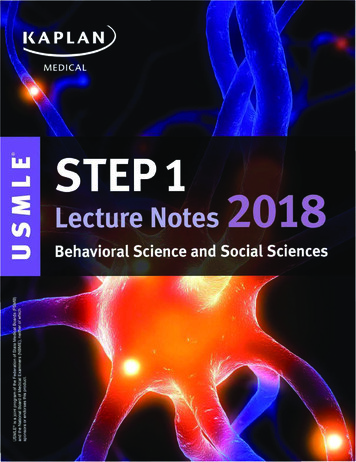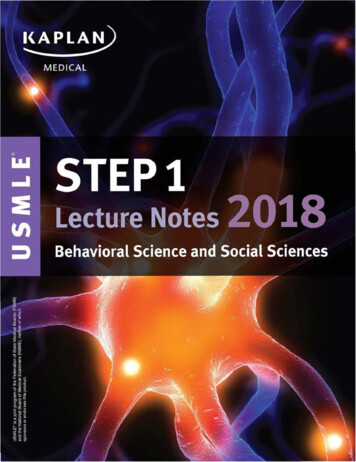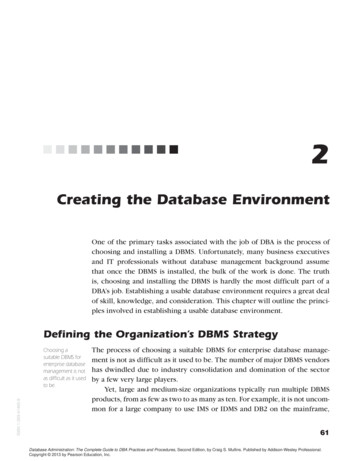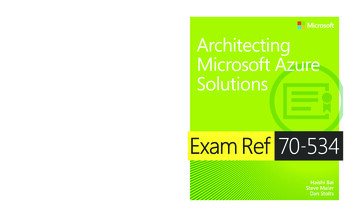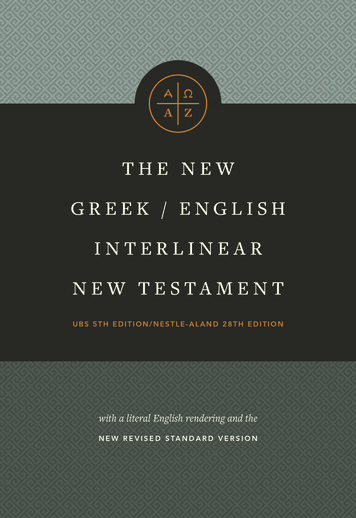
Transcription
A new interlinear translation of the Greek New TestamentUnited Bible Societies’ Fifth Revised EditionwithThe New Revised Standard Version, New TestamentTranslators: Robert K. Brown, Philip W. ComfortEditors: J. D. Douglas, Jonathan W. BryantEditors of the Greek New Testament, United Bible Societies’ Fifth Revised Edition (whichhas the same text as Novum Testamentum Graece, 28th edition): Barbara Aland, KurtAland, Johannes Karavidopoulos, Carlo M. Martini, and Bruce M. Metzger in cooperationwith the Institute for New Testament Textual Research, Münster/WestphaliaTyndale House Publishers, Carol Stream, Illinois
CREDITSTranslators:Robert K. BrownMatthew, Mark, Luke, Acts, HebrewsPhilip W. ComfortJohn, Paul’s Epistles, General Epistles, Revelation, and Textual NotesGeneral Editor: J. D. DouglasTyndale House Editor: Philip W. ComfortSpecial acknowledgments for others who shared in making this book:Bruce M. MetzgerChairperson of the Standard Bible Committee that produced the New Revised Standard VersionHarold P. Scanlinlnterregional Translation Adviser, United Bible SocietiesArthur O. Van EckAssociate General Secretary of the Division of Education and Ministry, National Council of the Churches ofChrist in the USAContributors to the updated edition (containing the UBS 5th Edition):Editor: Jonathan W. BryantTranslation updates: Mark D. Taylor, Jonathan W. BryantProofreaders: Ellen R. Vosburg, Sarah K. JohnsonDesigner: Daniel M. FarrellTypesetters: G. Patrick LaCosse, Matthew J. WolfVisit Tyndale online at tyndale.com.The New Greek/English Interlinear New TestamentCopyright 1990, 2020 by Tyndale House Publishers, Carol Stream, Illinois 60188. All rightsreserved.Cover illustration of Greek key pattern copyright thecorner/Depositphotos.com. All rightsreserved.The Greek New Testament, Fifth Revised Edition, edited by Barbara Aland, Kurt Aland, JohannesKaravidopoulos, Carlo M. Martini, and Bruce M. Metzger in cooperation with the Institute for NewTestament Textual Research, MÜnster/Westphalia, 2014 Deutsche Bibelgesellschaft, Stuttgart.Used by permission.New Revised Standard Version New Testament, copyright 1989, National Council of the Churches ofChrist in the United States of America. Used by permission. All rights reserved.TYNDALE and Tyndale’s quill logo are registered trademarks of Tyndale House Publishers.For information about special discounts for bulk purchases, please contact Tyndale HousePublishers at csresponse@tyndale.com, or call 1-800-323-9400.ISBN 978-1-4964-4398-4Printed in the United States of America267256245234223212201
C O N T E N T Svii Introduction toThe New Greek/English Interlinear New Testamentxix Preface toThe New Revised Standard Version, New UKEJOHNACTSROMANS1 CORINTHIANS2 1 THESSALONIANS2 THESSALONIANS1 TIMOTHY2 TIMOTHYTITUSPHILEMONHEBREWSJAMES1 PETER2 PETER1 JOHN2 JOHN3 JOHNJUDEREVELATION
INTRODUCTION TOThe New Greek/English Interlinear New TestamentR O B E R T K . B R O W N A N D P H I L I P W. C O M F O R TNew Testament Greek students all over the world recognize the superior quality oftwo editions of the Greek New Testament: the Greek New Testament, published by theUnited Bible Societies, and Novum Testamentum Graece, edited by Eberhard and ErwinNestle, followed by Kurt Aland. These two volumes represent the best in modern textualscholarship. In the 1970s a group of international scholars, each an expert in Greek andtextual criticism, worked together to produce a unified edition of these two texts. Thisunified edition was first displayed in the United Bible Societies’ third edition of the GreekNew Testament (1975), followed by the twenty-sixth edition of Novum Testamentum Graece(1979). Both editions shared the same wording in the text; the two, however, differed asto punctuation, paragraph breaks, spelling (in some instances), and the critical apparatus.The Greek text in this interlinear edition is the United Bible Societies’ Greek NewTestament, Fifth Edition (2014), the text of which corresponds to Novum TestamentumGraece, 28th Edition (2012).This Greek text, with an accompanying English interlinear translation, is now madeaccessible to even more readers of the New Testament. Very few people learn Greek wellenough to read the Greek New Testament unaided, so all Greek students (and formerGreek students) can benefit from an accurate interlinear translation of the Greek NewTestament. An interlinear translation also helps those who, though having very littleknowledge of Greek, want the most basic, word-for-word, literal translation of theGreek text. The interlinear translation in this book should provide all such students andreaders with a reliable, fresh rendering in modern English. Readers can be assured thatthe translators used the best lexical sources in preparing this translation. The Englishtranslation of many Greek words and phrases (including idioms) very often agrees withdefinitions and renderings found in the second edition of A Greek-English Lexicon of the NewTestament and Other Early Christian Literature, edited by Bauer, Arndt, Gingrich, and Danker.It is difficult to translate one language into another on a word-for-word basis becauseeach language has its own syntax, grammatical constructions, and idioms that aredifficult—if not impossible—to replicate literally in another language. To compensatefor this difficulty, we have created special symbols and procedures for rendering certainGreek grammatical constructions and idioms that cannot be translated smoothly intoEnglish on a word-for-word basis.The following is a concise list of some of the more commonly occurring special cases.It is, of course, impossible within the confines of an introduction to be comprehensive,particularly with regard to idioms of the Greek New Testament (which occur with someregularity). Also, it’s important to recognize that this introduction is designed to servemerely as a guide in understanding patterns employed in the English translation (i.e., thetypical ways that we have rendered certain constructions). Naturally, the specific context orthe complexity of the word order in a given passage may dictate a variation from the pattern.For a more detailed presentation of matters of Greek grammar and syntax, the reader isencouraged to consult the standard Greek grammars, lexicons, and reference works.
INTRODUCTIONviiiProcedures and Symbols in the English Translation1. Paragraph breaks are indicated by an indent in both the English and Greek lines of acouplet. (Please do not confuse this with the frequent indent of the English line dueto the presence of the chapter and verse number in the Greek line beginning at theleft margin.)2. shows an inversion of the Greek order into English.3. Superscript numbering (1, 2, 3, etc.) indicates English word order. This is used as an aidin situations where the ordering of the text is particularly difficult to follow.4. ( ) immediately following a word indicates an alternative rendering.5. [ ] indicates a supplied translation that is not found in the Greek text but is requiredby the context.6. You and your indicates “you” and “your” plural. (Greek, unlike English,distinguishes number in the second person personal pronoun.)7. - (the short dash, or hyphen) under a Greek word (frequently appearing with definitearticles) indicates that it was not necessary to translate that particular word orparticle into English.Symbols in the Greek Text1. indicate the beginning and ending of a textual variant; the corresponding variantreading(s) will be shown in a footnote at the bottom of the page (see, e.g., John 1:18).2. indicates a textual addition, present in some manuscripts, which will be shown in afootnote at the bottom of the page (see, e.g., John 5:3).3. [ ] (single brackets) indicate that the presence of the enclosed word(s) in the text is disputed.4. ⟦ ⟧ (double brackets) indicate that the enclosed words are generally regarded as lateradditions to the text, which have nonetheless been retained because of their evidentantiquity and their importance in the textual tradition.Textual NotesThe textual notes for the Greek text (which appear at the bottom of the page) are oftwo types: (1) those that provide Scripture references for portions of the Old Testamentcited in the New Testament text (indicated in the Greek text by italics) and (2) thosethat provide significant variant readings of the Greek text (designated in the footnotewith “var.” or, in the case of textual additions or omissions, with “add” or “omit”).
ixINTRODUCTIONEach note of the second type includes a listing of various English translations thatfollow one particular variant reading over the other(s). This list also shows (throughthe abbreviation “mg”) which translations make note of a particular variant readingin the margin (typically as a footnote). In the Old Testament references, “LXX” is anabbreviation for the Septuagint, a Greek translation of the Hebrew Scriptures.English Translations Appearing in the Textual NotesKJV: King James VersionNKJV: New King James VersionRSV: Revised Standard VersionNRSV: New Revised Standard VersionESV: English Standard VersionNASB: New American Standard BibleNIV84: New International Version (1984 edition)NIV11: New International Version (2011 edition)NEB: New English BibleREB: Revised English BibleRNJB: Revised New Jerusalem Bible: New Testament and PsalmsNAB: New American BibleNLT: New Living TranslationCSB: Christian Standard BibleNote on Gender-Inclusive LanguageThis book naturally lends itself to being as literal as possible in its word-for-wordtranslation. However, it should be noted that certain Greek terms rendered with genderspecific English words—perhaps most notably ἄνθρωπος (often translated as “man”)and ἀδελφός (translated as “brother”)—often carried a more inclusive meaning than ourcorresponding English words typically do. A comparison of the interlinear translationwith the corresponding NRSV text in the margin can provide readers with illustrations ofthe outworking of this principle.Grammatical/Syntactical Constructions1. GenitivesIn the majority of instances, the English preposition “of” has been employed todenote the genitive case. However, there are a few notable exceptions:a. objective genitive:Ἔχετε πίστιν θεοῦ.HAVEFAITH(Mark 11:22)IN GOD.
INTRODUCTIONxb. genitive of comparison:ἰσχυρότερός μούSTRONGERTHAN MEἐστιν,IS,(Matt. 3:11)c. genitive as direct object of certain verbs:καλοῦ ἔργου ἐπιθυμεῖ.A GOODWORKHE DESIRES.(1 Tim. 3:1)2. PossessivesThroughout this book, possessive pronouns that follow the noun they modify aregenerally rendered with the English word “of” followed by the pertinent pronoun(see, e.g., Luke 1:66 [“the heart of them”]) rather than using the symbol andinverting the word order (“their heart”). Instances in which possessives occur inother constructions and are thus treated differently from this practice include:a. genitive pronouns occurring before the noun they modify:εἰδὼςHAVING PERCEIVEDαὐτῶν τὴν ὑπόκρισινTHEIR-HYPOCRISY(Mark 12:15)b. possessive articles used before nouns indicating body parts:καὶ ἐκτείναςANDτὴνHAVING STRETCHED OUT THE (HIS)χεῖρα ἥψατοHANDαὐτοῦHE TOUCHED HIM(Matt. 8:3)c. dative of possession:ὄνομα αὐτῷ Ἰωάννης·NAMETO HIMJOHN.(John 1:6)3. ParticlesGreek particles serve many different functions and thus defy uniformity in howthey are rendered. Nonetheless, a number of tendencies appear in our translationfrequently enough to merit mention here:a. postpositive particles:τέξεται δὲAND SHE WILL BEAR(Matt. 1:21)υἱόν,A SON,
xiINTRODUCTIONb. negative particles adjacent to a verb (these are usually glossed in combination):Μὴ θησαυρίζετε ὑμῖνDO NOT STORE UPθησαυροὺςFOR YOU TREASURES(Matt. 6:19)c. μὴ at the beginning of a question expecting a negative answer:μὴσὺ[SURELY] NOT2μείζωνYOU3εἶGREATER THANARE1τοῦ πατρὸς ἡμῶν Ἰακώβ,THEFATHEROF US,JACOB,(John 4:12)d. ὅτι is not translated when it introduces direct speech or a quotation:καθὼς γέγραπταιJUST ASIT HAS BEEN WRITTEN,ὅτι-Οὐκ ἔστιν δίκαιοςTHERE IS NOTοὐδὲεἷς,A RIGHTEOUS [MAN] NOT EVEN ONE,(Rom. 3:10)e. μέν . . . δέ construction:Ὁ μὲνθερισμὸς πολύς,ON THE ONE HAND THEHARVEST[IS] GREAT,οἱ δὲBUT ON THE OTHER THEἐργάται ὀλίγοι·WORKERS[ARE] FEW.(Matt. 9:37)4. PluralsFrequently, a neuter plural subject takes a singular verb, as such subjects are generallythought to convey a collective sense. In many of these instances, we have simplytranslated into the natural English idiom without indicating actual grammatical form.In the example below, even though ἐστιν is a singular verb, it is translated “are” toappropriately correspond to the plural subject τὰ ῥήματα.τὰ ῥήματα ἃTHE WORDSἐγὼ λελάληκα ὑμῖνWHICH IHAVE SPOKENTO YOU πνεῦμά ἐστιν καὶ ζωή ἐστιν.ARE SPIRITANDARE LIFE.(John 6:63)Sometimes, Greek plural nouns are translated with words that, in English, haveidentical spellings in their singular and plural forms, such as “bread,” “fish,” and“sheep.”Καὶ ἐπελάθοντο λαβεῖν ἄρτουςANDTHEY FORGOTTO TAKEBREAD(Mark 8:14)5. Verbs requiring their object to complete their sense are often treated as a unit:σκανδαλίζει σε,CAUSES YOU TO STUMBLE,(Matt. 5:29)
INTRODUCTIONxiiSome Common Idioms1. ἵνα μὴLEST2. μὴ γένοιτοMAY IT NEVER BE3. δεῖIT IS NECESSARY4. διὰ τοῦτοTHEREFORE5. καθ ἡμέρανDAILY6. τοῦτ ἔστινTHAT IS7. διὰ παντὸςALWAYS / CONTINUALLY8. ἐπὶ τὸ αὐτόTOGETHERTransliterationsA number of Hebrew and Aramaic words carried over into the Greek language have beentransliterated rather than translated, such as “Abba” (see Gal. 4:6), “amen” (see Eph.3:21), “Marana tha” (see 1 Cor. 16:22), and “raca” (see Matt. 5:22). Also, measurements,weights, and currency have been transliterated rather than translated, such as “stadia”(see John 11:18), “talents” (see Matt. 25:15), and “denarii” (see Matt. 18:28).VERBS, INFINITIVES, AND PARTICIPLESTense and VoiceWe have attempted to translate verbs, infinitives, and participles within the stricttense guidelines listed below. However, conditional sentences, idiomatic phrases, andat times the very context of the passage demand a less rigid approach. The paradigmbelow could give the impression that tense for Greek verbs, infinitives, and participlesis primarily temporal. Therefore, it must be said that “tense” in Greek indicates thekind of action more than the time of action. For example, an aorist participle maynot indicate some action done in the past; rather, it could designate a present actiondone at a particular point in time (rather than being a continuous action, or an actionhaving continued results). In fact, the aorist participle may function as a participle ofattendant circumstance without reflecting the temporal sense at all (which is insteadconveyed through the main verb). At its core, the aorist reflects a kind of action (called“punctiliar”—referring to a point in time) more than an action done in the past, even as,in translation, the English past tense might frequently work best.
xiiiINTRODUCTIONA Paradigm of English Renderings for Greek VerbsACTIVEPASSIVEPRESENTI love/am lovingI am loved/am being lovedFUTUREI will loveI will be lovedIMPERFECTI was lovingI was being lovedAORISTI lovedI was lovedPERFECTI have lovedI have been lovedPLUPERFECTI had lovedI had been lovedNote: The forms of the middle voice and the passive voice are often indistinguishable inGreek, frequently resulting in ambiguity. When context clearly suggests the middle voiceis intended, we have often denoted that through the use of a reflexive pronoun, as in thetranslation of ἐνδυσάμενος in Acts 12:21: “having clothed himself.”MoodIndicativeThe indicative mood, by far the most frequent mood appearing in the New Testament,is, generally speaking, used to convey statements that are factual. As such, verbs in thismood have been translated simply (usually with just one word, sometimes including animplied subject).Βαρναβᾶς δὲ καὶ Σαῦλος ὑπέστρεψαν εἰς Ἰερουσαλὴμ AND BARNABASANDSAULRETURNEDTOJERUSALEM,(Acts 12:25)Ἐν τούτῳ γινώσκομεν ὅτι ἐν αὐτῷ μένομενBYTHISWE KNOWTHAT INHIMWE REMAIN(1 Jn. 4:13)SubjunctiveThe subjunctive mood, generally denoting action that is probable or hypothetical, hasbeen conveyed in our translation with the use of “might” or “may” whenever possible.But this was not always possible, particularly with conditional sentences (whichinherently convey the subjunctive sense, rendering the “might” or “may” unnecessary).Occasionally, “could,” “should,” or “let [me/us]” was used to indicate the subjunctivemood, especially in exhortations. A notable construction that occurs quite frequentlyin the New Testament is οὐ μή an aorist subjunctive verb, which conveys an emphaticnegation. We have rendered such constructions with the phrasing “will by no means . . .”
� τοῖς ἴχνεσιν αὐτοῦ,IN ORDER THATYOU MIGHT FOLLOWIN THE STEPSOF HIM,(1 Pet. 2:21)οἱ δὲ λόγοι μου οὐ μὴ παρέλθωσιν.BUT THE WORDSOF MEWILL BY NO MEANS PASS AWAY.(Matt. 24:35)OptativeThe optative mood, which seldom appears in the New Testament, is used to denoteaction that is possible (generally more hypothetical than the subjunctive) or to expressa wish. As with the translation of the subjunctive, we have typically employed “might” toconvey the optative mood.εἴ πωςIFδύναιντοSOMEHOW THEY MIGHT BE ABLE(Acts 27:12)τί ἂν θέλοιWHATκαλεῖσθαι αὐτό.HE MIGHT WISH IT (HIM) TO BE CALLED.(Luke 1:62)ImperativeIn the imperative mood, it is very difficult to make a distinction in an English translationbetween the tenses. As such, imperatives have largely been treated in a straightforwardfashion as simple commands (“go,” “come,” etc.), regardless of tense. In instances wherethe imperative is in the third person, the translation usually necessitates the form “lethim/her/them/that one . . .”Ἀκούσατε, ἀδελφοί μου s. 2:5)εἰ δὲ ὁBUT IFTHEἄπιστοςUNBELIEVING ONEχωρίζεται, χωριζέσθω·SEPARATES,LET THAT ONE SEPARATE;(1 Cor. 7:15)InfinitivesInfinitives (verbal nouns) occur frequently in New Testament Greek, and they performa variety of functions. Infinitives can appear within various constructions (often with apreceding preposition), and our translation has employed numbering as an aid for someof the more complex infinitive constructions. It is important to note that infinitives takesubjects in the accusative case rather than the nominative case. Here is a list of a fewcommon infinitive constructions:
xvINTRODUCTION1. τοῦ infinitive, εἰς τό infinitive, or πρὸς τό infinitive to express purpose:μέλλει γὰρ Ἡρῴδης ζητεῖν τὸ παιδίον τοῦ ἀπολέσαι αὐτό.3IS ABOUTFOR12HERODTO SEEKTHE CHILD-TO KILLIT.(Matt. 2:13)μαρτυρόμενοι εἰςTESTIFYINGIN ORDER THATτὸ περιπατεῖν ὑμᾶς ἀξίωςYOU WALK-WORTHILYτοῦ θεοῦ-OF GOD,(1 Thes. 2:12)ἐνδύσασθε τὴν πανοπλίαν τοῦ θεοῦ πρὸςPUT ONTHEWHOLE ARMOR-OF GOD IN ORDER THATτὸ δύνασθαι ὑμᾶς στῆναιYOU ARE ABLE-TO STAND(Eph. 6:11)2. ἐν τῷ infinitive or μετὰ τὸ infinitive to express a temporal relationship with themain verb:Καὶ ἐν τῷ συμπληροῦσθαι τὴν ἡμέραν τῆς πεντηκοστῆςANDWHEN4WAS FULFILLEDTHE12DAY-3OF PENTECOST(Acts 2:1)Μετὰ δὲ τὸ παραδοθῆναι τὸν ἸωάννηνAND AFTER-2WAS IMPRISONED-JOHN1(Mark 1:14)3. ὥστε infinitive to express result:ἔπλησαν ἀμφότερα τὰ πλοῖα ὥστε βυθίζεσθαι αὐτά.THEY FILLEDBOTH-SO THAT THEY BEGAN TO SINK.BOATS(Luke 5:7)4. διὰ τὸ infinitive to express cause:εἶπεν παραβολὴν διὰ τὸ ἐγγὺς εἶναι Ἰερουσαλὴμ αὐτὸνHE TOLD A PARABLEBECAUSE3NEAR2WAS4JERUSALEMHE1(Luke 19:11)5. Infinitive as a substantive:ἐμοὶ γὰρ τὸ ζῆνFOR TO ME-Χριστὸς καὶ τὸ ἀποθανεῖν κέρδος.TO LIVE [IS] CHRISTAND-TO DIE[IS] GAIN.(Phil. 1:21)ParticiplesGreek participles are notoriously difficult to grasp, yet extremely common in the NewTestament. They serve a multitude of functions, mostly adjectival or adverbial, thoughoccasionally substantival. In what follows, we provide a paradigm for a basic renderingof Greek participles, along with some examples of how we’ve generally opted to rendercertain prominent participial constructions.
INTRODUCTIONxviA Paradigm of English Renderings for Greek ParticiplesACTIVEPASSIVEPRESENTlovingbeing lovedAORISThaving lovedhaving been lovedPERFECThaving lovedhaving been lovedNoteworthy Constructions Involving the Participle1. Substantival participle:οὗτός ἐστιν ὁTHISISβαπτίζων ἐνTHE ONEBAPTIZINGπνεύματι ἁγίῳ.[THE] HOLY SPIRIT.WITH(John 1:33)2. Adjectival participle:ἐν τῇ διδασκαλίᾳ τῇ s 1:9)3. Genitive absolute:The genitive absolute construction consists of a series of words in the genitive case,including a genitive participle, that is grammatically disconnected from the rest ofthe sentence. (Occasionally it consists of just one word—the genitive participle.)Most commonly, the genitive absolute is used to denote circumstances temporallyrelated to the main verb of the sentence. Because genitive absolute constructions canbe rather lengthy, we have sometimes employed numbering in our translation of suchconstructions.Ἀναχωρησάντων δὲ αὐτῶν ἰδοὺ ἄγγελοςNOW [AFTER] THEY DEPARTEDLOOK,AN ANGELκυρίουOF [THE] LORDφαίνεταιAPPEARS(Matt. 2:13)ἔτι3STILLἁμαρτωλῶν ὄντων ἡμῶν4SINNERS2WERE[WHILE] WE1Χριστὸς ὑπὲρCHRISTἡμῶν ἀπέθανεν.ON BEHALF OF USDIED.(Rom. 5:8)4. Attendant circumstance:An attendant circumstance participle expresses an action that occurs independentlyof but alongside the action of the main verb. It is essentially treated as a finite verbrather than being rendered as dependent on the main verb (i.e., in translation, it lookslike a regular verb, not a participle).καὶ εἶπεν αὐτῷ, Ἀναστὰς πορεύου·ANDHE SAID(Luke 17:19)TO HIM,RISE UP[AND] GO.
xviiINTRODUCTION5. Periphrastic constructions:Periphrastic constructions consist of a main verb (usually εἰμί [the “to be” verb])followed by a participle, which together form a single verbal construction. The mainverb adds only grammatical information; it does not convey semantic information.The combination of the tenses of the two elements determine the tense of thecombined verbal construction (see below). For the purposes of our translation, sincethe two elements of a periphrastic are only understood together, they are renderedtogether in a combined gloss. (Note: Sometimes in the Greek word order, the “tobe” verb and the participle are separated by multiple words, in which case we havegenerally placed the combined gloss under the participle.)a. Present periphrastic (present of εἰμί present participle):ὅἐστιν μεθερμηνευόμενονWHICH IS TRANSLATED(Mark 5:41)b. Imperfect periphrastic (imperfect of εἰμί present participle):πλῆθος ἦν τοῦMULTITUDE -λαοῦ προσευχόμενονOF THEPEOPLE WERE PRAYING(Luke 1:10)c. Future periphrastic (future of εἰμί present participle):ἔσεσθε μισούμενοι ὑπὸ πάντωνYOU WILL BE HATEDBYEVERYONE(Mark 13:13)d. Perfect periphrastic (present of εἰμί perfect participle):οὐδὲν δὲ συγκεκαλυμμένον ἐστὶνAND NOTHINGHAS BEEN CONCEALED(Luke 12:2)e. Pluperfect periphrastic (imperfect of εἰμί perfect participle):μνημείῳ ὃA TOMBἦν λελατομημένον ἐκWHICH HAD BEEN CUTπέτραςFROM ROCK(Mark 15:46)f. Future perfect periphrastic (future of εἰμί perfect participle):ἔσται δεδεμένα ἐν οὐρανῷ,WILL HAVE BEEN BOUND(Matt. 18:18)INHEAVEN,
INTRODUCTIONxviiiWe, the translators, enjoyed working with one another and with the editor, J. D. Douglas,on this book. Our labor will be rewarded if this New Greek/English Interlinear NewTestament provides greater accessibility to the original language of the New Testament,encourages further study of the Greek text, and enhances fuller knowledge of God’sWord and of his Son, Jesus Christ.
PREFACE TOThe New Revised Standard Version, New TestamentTO THE READERThis preface is addressed to you by the Committee of translators, who wish to explain, asbriefly as possible, the origin and character of our work. The publication of our revisionis yet another step in the long, continual process of making the Bible available in theform of the English language that is most widely current in our day. To summarize in asingle sentence: the New Revised Standard Version of the Bible is an authorized revisionof the Revised Standard Version, published in 1952, which was a revision of the AmericanStandard Version, published in 1901, which, in turn, embodied earlier revisions of theKing James Version, published in 1611.In the course of time, the King James Version came to be regarded as “the AuthorizedVersion.” With good reason it has been termed “the noblest monument of English prose,”and it has entered, as no other book has, into the making of the personal character andthe public institutions of the English- speaking peoples. We owe to it an incalculable debt.Yet the King James Version has serious defects. By the middle of the nineteenthcentury, the development of biblical studies and the discovery of many biblicalmanuscripts more ancient than those on which the King James Version was based madeit apparent that these defects were so many as to call for revision. The task was begun, byauthority of the Church of England, in 1870. The (British) Revised Version of the Biblewas published in 1881– 1885; and the American Standard Version, its variant embodyingthe preferences of the American scholars associated with the work, was published, aswas mentioned above, in 1901. In 1928 the copyright of the latter was acquired by theInternational Council of Religious Education and thus passed into the ownership of theChurches of the United States and Canada that were associated in this Council throughtheir boards of education and publication.The Council appointed a committee of scholars to have charge of the text of theAmerican Standard Version and to undertake inquiry concerning the need for furtherrevision. After studying the questions whether or not revision should be undertaken,and if so, what its nature and extent should be, in 1937 the Council authorized a revision.The scholars who served as members of the Committee worked in two sections, onedealing with the Old Testament and one with the New Testament. In 1946 the RevisedStandard Version of the New Testament was published. The publication of the RevisedStandard Version of the Bible, containing the Old and New Testaments, took placeon September 30, 1952. A translation of the Apocryphal/Deuterocanonical Books ofthe Old Testament followed in 1957. In 1977 this collection was issued in an expandededition, containing three additional texts received by Eastern Orthodox communions(3 and 4 Maccabees and Psalm 151). Thereafter the Revised Standard Version gainedthe distinction of being officially authorized for use by all major Christian churches:Protestant, Anglican, Roman Catholic, and Eastern Orthodox.The Revised Standard Version Bible Committee is a continuing body, comprisingabout thirty members, both men and women. Ecumenical in representation, it includesscholars affiliated with various Protestant denominations, as well as several Roman
PREFACE TO THE NRSVxxCatholic members, an Eastern Orthodox member, and a Jewish member who servesin the Old Testament section. For a period of time the Committee included severalmembers from Canada and from England.Because no translation of the Bible is perfect or is acceptable to all groups ofreaders, and because discoveries of older manuscripts and further investigation oflinguistic features of the text continue to become available, renderings of the Biblehave proliferated. During the years following the publication of the Revised StandardVersion, twenty- six other English translations and revisions of the Bible were producedby committees and by individual scholars— not to mention twenty- five other translationsand revisions of the New Testament alone. One of the latter was the second edition ofthe RSV New Testament, issued in 1971, twenty- five years after its initial publication.Following the publication of the RSV Old Testament in 1952, significant advanceswere made in the discovery and interpretation of documents in Semitic languages relatedto Hebrew. In addition to the information that had become available in the late 1940sfrom the Dead Sea texts of Isaiah and Habakkuk, subsequent acquisitions from the samearea brought to light many other early copies of all the books of the Hebrew Scriptures(except Esther), though most of these copies are fragmentary. During the same periodearly Greek manuscript copies of books of the New Testament also became available.In order to take these discoveries into account, along with recent studies of documentsin Semitic languages related to Hebrew, in 1974 the Policies Committee of the RevisedStandard Version, which is a standing committee of the National Council of the Churchesof Christ in the U.S.A., authorized the preparation of a revision of the entire RSV Bible.For the New Testament the Committee has based its work on the most recentedition of The Greek New Testament, prepared by an interconfessional and internationalcommittee and published by the United Bible Societies (1966; 3rd ed. corrected, 1983;information concerning changes to be introduced into the critical apparatus of theforthcoming 4th edition was available to the Committee). As in that edition, doublebrackets are used to enclose a few passages that are generally regarded to be lateradditions to the text, but which we have retained because of their evident antiquity andtheir importance in the textual tradition. Only in very rare instances have we replacedthe text or the punctuation of the Bible Societies’ edition by an alternative that seemed tous to be superior. Here and there in the footnotes the phrase, “Other ancient authoritiesread,” identifies alternative readings preserved by Greek manuscripts and early versions.Alternative renderings of the text are indicated by the word “Or.”As for the style of English adopted for the present revision, among the mandates givento the Committee in 1
Matthew, Mark, Luke, Acts, Hebrews Philip W. Comfort John, Paul’s Epistles, General Epistles, Revelation, and Textual Notes General Editor: J. D. Douglas Tyndale House Editor: Philip W. Comfort Special acknowledgments for others who shar


